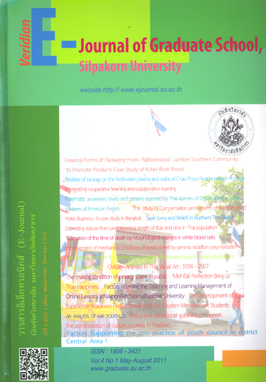การพัฒนารูปแบบการเตรียมความพร้อมการฝึกประสบการณ์วิชาชีพ สำหรับนักศึกษาสาขาวิชาการจัดการการท่องเที่ยว
Main Article Content
Abstract
บทคัดย่อ
การวิจัยนี้มีวัตถุประสงค์ของการวิจัย 1) เพื่อพัฒนารูปแบบการเตรียมความพร้อมการฝึก ประสบการณ์วิชาชีพสำหรับนักศึกษาสาขาวิชาการจัดการการท่องเที่ยว 2) เพื่อประเมินประสิทธิภาพและ ประสิทธิผลของรูปแบบการเตรียมความพร้อมการฝึกประสบการณ์วิชาชีพสำหรับนักศึกษาสาขาวิชาการ จัดการการท่องเที่ยว กลุ่มตัวอย่างที่ใช้ในการวิจัยครั้งนี้เป็นนักศึกษาสาขาวิชาการจัดการการท่องเที่ยว ชั้นปี ที่ 2 สาขาวิชาการจัดการการท่องเที่ยว คณะวิทยาการจัดการ มหาวิทยาลัยศิลปากร จำนวน 18 คน ภาค การศึกษาที่ 2 ปีการศึกษา 2552 เครื่องมือที่ใช้ในการวิจัยประกอบด้วย รูปแบบการเตรียมความพร้อมการ ฝึกประสบการณ์วิชาชีพสำหรับนักศึกษาสาขาวิชาการจัดการการท่องเที่ยวกับรูปแบบการเตรียมความพร้อม แบบปกติ แผนการจัดการเรียนรู้ แบบประเมินความพร้อมการฝึกประสบการณ์วิชาชีพ และแบบสัมภาษณ์ ความคิดเห็นของนักศึกษาที่มีต่อรูปแบบการเตรียมความพร้อมการฝึกประสบการณ์วิชาชีพ การวิเคราะห์ ข้อมูลใช้ ร้อยละ ค่าเฉลี่ย ส่วนเบี่ยงเบนมาตรฐาน การวิเคราะห์ค่าความแปรปรวน ANOVA และการ วิเคราะห์เนื้อหา
ผลการวิจัยพบว่า
1. รูปแบบการเตรียมความพร้อมการฝึกประสบการณ์วิชาชีพที่พัฒนาขึ้นเรียกว่า EDCATOPPPP Model มีองค์ประกอบ คือ หลักการ มุ่งเน้นการพัฒนานักศึกษาให้มีคุณภาพด้านร่างกาย จิตใจ และสังคม ให้มีความสามารถในงานบริการและปรับตัวให้ทันต่อการเปลี่ยนแปลง วัตถุประสงค์ เพื่อพัฒนานักศึกษา สาขาวิชาการจัดการการท่องเที่ยวให้มีความพร้อมในการฝึกประสบการณ์วิชาชีพ ความพร้อมการฝึก ประสบการณ์วิชาชีพ ประกอบด้วย 3 คุณสมบัติ คือ คุณสมบัติด้านทัศนคติ คุณสมบัติด้านลักษณะนิสัย และคุณสมบัติด้านความรู้และทักษะ เทคนิควิธีการเรียนรู้ และการประเมินผล ซึ่งมีขั้นตอนการจัด ประสบการณ์การเรียนรู้ ในห้องเรียน 4 ขั้น คือ 1) สร้างประสบการณ์ (Experience: EPPP) 2) อภิปราย แลกเปลี่ยนเรียนรู้ (Discussion: DPPP) 3) สรุป (Conceptualization: CPPP) และ 4) ประยุกต์ใช้ (Application: APPP) นอกห้องเรียน 3 ส่วนคือ 1) ศึกษาดูงาน (Study Tour: TPPP) 2) สังเกตการณ์ (Observe: OPPP) และ 3) ปฏิบัติ (Practice: PPPP) และรูปแบบการเตรียมความพร้อมการฝึกประสบการณ์ วิชาชีพสำหรับนักศึกษาสาขาวิชาการจัดการการท่องเที่ยวมีประสิทธิภาพ เท่ากับ 85.93/89.07 เมื่อเทียบ กับเกณฑ์ 80/80 ปรากฏว่าสูงกว่าเกณฑ์ที่กำหนดไว้
2. ความพร้อมการฝึกประสบการณ์วิชาชีพของนักศึกษาสาขาวิชาการจัดการการท่องเที่ยวที่ เตรียมความพร้อมด้วยรูปแบบการเตรียมความพร้อมการฝึกประสบการณ์วิชาชีพสูงกว่านักศึกษาที่ได้รับ รูปแบบการเตรียมความพร้อมแบบปกติแตกต่างกันอย่างมีนัยสำคัญทางสถิติที่ระดับ .05
3. ความคิดเห็นของนักศึกษาที่มีต่อรูปแบบการเตรียมความพร้อมการฝึกประสบการณ์วิชาชีพ นักศึกษามีความคิดเห็นว่ามีความเหมาะสมในการเตรียมความพร้อมมากที่สุด ในด้าน การฝึกทักษะการ ปฏิบัติ ฝึกการทำงานกลุ่ม ฝึกการแก้ปัญหา ฝึกการสื่อสาร การจัดเวลาให้เหมาะสมกับกิจกรรมในการเตรียม ความพร้อม และจัดกิจกรรมให้สามารถเชื่อมโยงความรู้สู่การปฏิบัติ
คำสำคัญ : การพัฒนารูปแบบ, การเตรียมความพร้อมการฝึกประสบการณ์วิชาชีพ, นักศึกษาสาขาวิชา การจัดการการท่องเที่ยว
Abstract
The objectives of this research were: 1) to develop a readiness preparation model for professional experience training for tourism management students; and 2) to evaluate the efficiency and effectiveness of the readiness preparation model for professional experience training. The study sample consisted of 18 second-year tourism management students in the Faculty of Management Sciences, Silpakorn University, in the second semester, academic year 2009. The instruments used were: a readiness preparation model for professional experience training for tourism management students and a normal readiness preparation model for professional experience training; learning management plans; an evaluation form to check for experience training readiness; and a form of structured interview on opinions towards the readiness preparation model for professional experience training. Data were analyzed in terms of percent, average mean, standard deviation. F-test ANOVA and content analysis were also used.
The research results revealed as follows:
1. The readiness preparation model for professional experience training was developed and called EDCATOPPPP. The model was composed of principles, objectives, procedures of learning experience management, readiness for experience training, and three characteristics related to students, namely, attitude characteristics, habit characteristics, and the characteristics of knowledge and skills, and learning and evaluation techniques. The procedures of learning experience management inside classroom consisted of 4 steps including: 1) experience development (Experience: EPPP); 2) discussion and learning sharing (Discussion: DPPP); 3) conclusion (Conceptualization: CPPP); and 4) application (Application: APPP). The procedures of learning experience management outside classroom consisted of 3 parts including 1) study tour (Study Tour: TPPP); 2) observation (Observe: OPPP); and 3) practice (Practice: PPPP). The efficiency of the readiness preparation model for professional experience training for tourism management students, was 85.93/89.07, which was higher than the given criteria of 80/80.
2. The experience training of the tourism management students who were prepared by the experience preparation model for tourism management students was higher than that of those prepared by the normal readiness preparation model for professional experience training, and they were significantly different at .05 statistical level.
3. For the opinions of the students towards the readiness preparation model for professional experience training, the students perceived that it was the most suitable to prepare students’ readiness in terms of the trainings of practical skills, group working, problem solving, communication training, management of appropriate time for readiness preparation activities, and management of activities properly linking knowledge to practice.
Keywords : Model Development, Experience Readiness Preparation, Tourism Management Students

